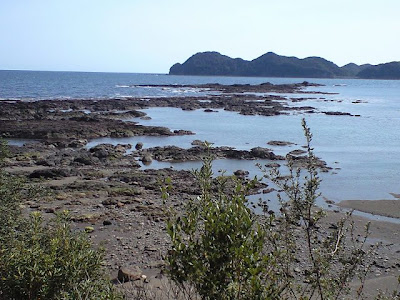 At one point we walked up a hill and through a v-shaped cut at the top. The sides of the V protected us from both the wind and the rain. However, when reached the end of the cut, we could see that we had to cross a bridge over a river and the road was at least 20 meters above the river's surface, maybe even more. I was walking on the left side of the road and, since there were sidewalks on both sides of the bridge, I kept going straight. Surprise! As I stepped out of the shelter of the cut, it felt like someone punched me, or maybe I had been hit by a car. I was knocked sideways and, when I had recovered my balance, I found myself in the middle of the road. Luckily there were no cars at that moment. I hurried back onto the sidewalk, but found that since the wind was coming from my left, I could not stay on the sidewalk, being constantly pushed back into the road by the gale. Finally, Ian and I crossed the road so that we had a railing on our right. We were then able to proceed by letting the wind push us against the rail and sort of sliding ahead. The bridge was only about 100 meters long, but I was exhausted when I reach shelter on the other side.
At one point we walked up a hill and through a v-shaped cut at the top. The sides of the V protected us from both the wind and the rain. However, when reached the end of the cut, we could see that we had to cross a bridge over a river and the road was at least 20 meters above the river's surface, maybe even more. I was walking on the left side of the road and, since there were sidewalks on both sides of the bridge, I kept going straight. Surprise! As I stepped out of the shelter of the cut, it felt like someone punched me, or maybe I had been hit by a car. I was knocked sideways and, when I had recovered my balance, I found myself in the middle of the road. Luckily there were no cars at that moment. I hurried back onto the sidewalk, but found that since the wind was coming from my left, I could not stay on the sidewalk, being constantly pushed back into the road by the gale. Finally, Ian and I crossed the road so that we had a railing on our right. We were then able to proceed by letting the wind push us against the rail and sort of sliding ahead. The bridge was only about 100 meters long, but I was exhausted when I reach shelter on the other side.By noon time we were nearing our lodging, after walking only 14 kilometers. I was tired and wet. Since we were the only guests that night, they let us each have a separate room. When I got my pack unloaded and the stuff put out to dry, I took off my clothes and changed in the yukata (light robe) that is always provided in this sort of place. When I removed my stockings, I discovered that the blisters on my left foot were huge, so after a both, I broke them with a needle and retaped them. In addition to the rotten weather and the blisters and a sunburn on my hands, I had not felt good all day. I thought it might have something to do with the fact that it was Friday, the 13th. However, when I starting thinking about this, I realized that there had been a lot of good, too. The coffee shop and been a real treat. The short walk and private rooms were a bonus. Also, this place, the Michishio Lodge, was normally frequented by surfers so they had a piece of equipment that I had never seen before, but it was really useful. It was a shoe dryer. There was a rack to put the shoes on and a fan and heater blew hot air into the inside of the shoes to dry them. We were there long enough to dry both our shoes.
I spent most of the afternoon laying around in my room watching an old Ingrid Bergman movie on TV. In the evening I had a vegetarian meal (no fish) and Ian and I ate in his room. The next morning we had breakfast in mine.
The following pictures show the beach near the lodge. You can see how bad the weather was. We were both very happy to be warm and dry in our own rooms, rather than out hiking through the storm. The last two pictures were taken out the window of Ian's room.




















































